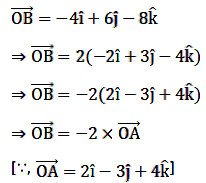Let us understand that, two more points are said to be collinear if they all lie on a single straight line. We have been given position vectors \(2\hat i-3\hat j+4\hat k\) and \(-4\hat i+6\hat j-8\hat k\)
Let
\(\vec A=2\hat i-3\hat j+4\hat k\)
\(\vec B=-4\hat i+6\hat j-8\hat k\)
Also, let O be the initial point having position vector as
\(\vec O=0\hat i+0\hat j-0\hat k\)
Now, let us find \(\vec {OA}\) and \(\vec {OB}\).
\(\vec {OA}\) is given by
\(\vec {OA}\) = Position vector of \(\vec A\) - Position vector of \(\vec O\)

\(\vec {OB}\) is given by
\(\vec {OB}\) = Position vector of \(\vec B\) - Position vector of \(\vec O\)

\(\vec {OB}\) is given by
\(\vec {OB}\) = Position vector of \(\vec B\) - Position vector of \(\vec O\)

We have \(\vec {OB}\) as

Thus, this relation shows that \(\vec {OA}\) and \(\vec {OB}\) are parallel to each other.
But also, \(\vec O\) is the common vector in \(\vec {OA}\) and \(\vec {OB}\).
⇒ \(\vec {OA}\) and \(\vec {OB}\) are not parallel but lies on a straight line.
⇒ A and B are collinear.
Hence, \(2\hat i-3\hat j+4\hat k\) and \(-4\hat i+6\hat j-8\hat k\) are collinear.